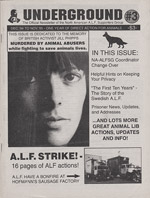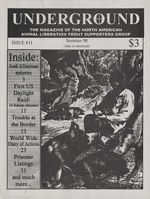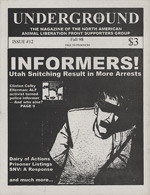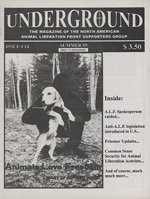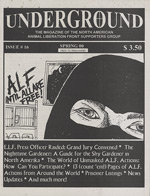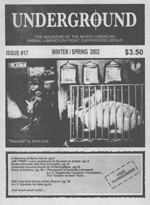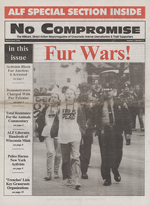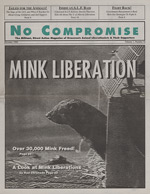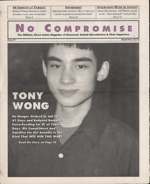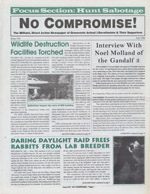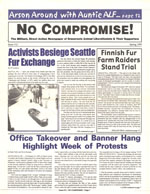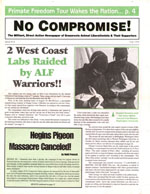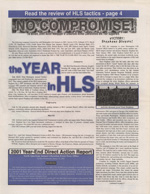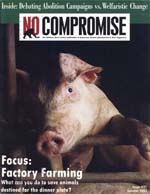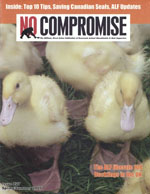The history covered in these volumes spans the most active period of direct actions for non-humans in both Canada and the United States. Among the various news articles and opinion pieces one can find plenty of infighting and internal critique, and often those debates ended up being the reason the next issue was delayed. Underground was plagued by the same problems as most small press, volunteer efforts: lack of funding, constantly rotating staff, and difficulties with printers and distributors. Despite all of this, Underground was amazing! Each issue was eagerly awaited during it’s print run, and it was widely read among the more radical portions of the movement.
Katie Fedor
The Complete No Compromise
No Compromise 1-30. Includes Strategic Non-Violence for Animal Liberation insert included with issue #8 as separate publication. (1996-2006, Sacramento, CA / Minneapolis, MN / Caldwell, NJ / Old Bridge, NJ / Santa Cruz, CA / San Francisco, CA)
Text postNo Compromise, which billed itself as “The militant, direct action newsmagazine of grassroots animal liberationists and their supporters,” was the most important animal rights publication of the 1990s. Despite its many problems, frequent delays, and constant changes in editorial staff, the magazine energized the movement in a way that is difficult to explain to a generation that never witnessed pre-internet activism.
In the mid 90s there were a few, isolated groups around the country who were participating in civil disobedience actions and staging loud protests against local labs and fur stores. These groups were largely unaware of each others’ existence and without a gathering like Earth First!’s Round River Rendezvous, unable to share tactical advice or co-ordinate targets.
In 1996 there was a national meeting of animal rights activists in Washington DC dubbed World Animal Awareness Week and March for the Animals. The event was considered a failure as only 3,000 of the estimated 100,000 participants materialized. But staff from No Compromise were present passing out the first issue and asking grassroots organizations for their contact information. Suddenly groups like the Animal Rights Direct Actions Coalition were meeting with the Coalition to Abolish the Fur Trade, the Animal Defense Leagues, and the Student Organization for Animal Rights.
As the grassroots grew increasingly aware of the efforts of other organizations, regional demonstrations began being planned. The first such demonstration after the March for Animals took place at the Seattle Fur Exchange, where activists used bike locks to attach themselves to each other and block the drive way of the fur auction. All of the action got reported on in No Compromise, and suddenly bike locks gave way to lock boxes, which gave way to super boxes and barrels and tripods as civil disobedience tactics spread across the country wherever the magazine was distributed. There was an explosion not just in voluntary arrest scenarios, but also in underground direct action. The print runs of No Compromise kept climbing and it became the must read publication for animal rights militants.
The tone of the magazine at its start was hopeful, and each issue was packed with increasingly daring protests and direct actions. As the movement struggled to find focus and dealt with the departure of founder Freeman Wicklund, the the mood shifts to frustration and confusion, only to be plucked back into hopeful territory with the rise of SHAC.
After 30 issues, the steering committee of No Compromise decided to stop publishing in 2006. Their decision could not have come at a worse time. With the SHAC website and newsletter killed by the convictions of the SHAC 7, Bite Back being published only sporadically and with a limited focus, and the Earth First! Journal mired in infighting, the sudden absence of No Compromise meant that the primary sources for radical animal liberation news, opinion, and strategy were the twin sewers of online social networks and the North American Animal Liberation Press Office. These were dark times for our movement, and we are only just beginning to recover.
Facklan
Facklan (1996-1997 Umea, Sweden)
(Editors note: Facklan is a Swedish language publication that we bring to you due to its historical significance. Umea, Sweden produced one of the most remarkable animal liberation communities of the 1990s. Their influence was so strong that politicians in Sweden stated in national media that they feared animal rightists may collapse the countries infrastructure, both through sabotage and the conversion of the nations youth to veganism. Facklan was produced during the infancy of this tiny, but formidable uprising. One of our readers from Sweden has offered the summary that follows.)
Facklan (The Torch) was a Swedish magazine supporting the A.L.F. and
other radical groups fighting for the animals. It was released in four
issues in 1996-1997, during the biggest peak of A.L.F. activity in the
1990:ies in Sweden. The magazine was based in the northern city Umea,
which was well known for it’s number of vegans and animal rights
activists, militant (all fur shops closed in Umea as a result of the
A.L.F.) as well as non militant (almost 50 percent of the students at
some schools were vegetarians). Umea was often referred to as the
“Vegan Mecca”, and was also well known for bands promoting the animal
rights message, such as Refused.
The first issue contained translated interviews etc from mainly UK and
US sources, and also had copied text from the Swedish militant
activist/anarchist manual Lila Svarta. Of course there was also a
diary of actions and addresses to imprisoned animal rights activists.
Two spreads were also dedicated to show mainstream media articles from
the time, also serving as a sign of the impact of the A.L.F. activity.
During the later issues, more of the content was produced by Swedish
authors. In the second issue, there were a lot of more news from
Sweden and Finland, letters to the editor, communiques from the newly
started group The Wild Minks, a report from the riot against the fur
auction in Skara, a piece on the repression of Umea acitivists,
reviews of records under the headline “Activist Core”, and now also a
diary of actions focusing on Sweden. Content from abroad was still
used though, this time information from The Final Nail and on Barry
Horne. On the last page, a summary in English was also published for
the foreign readers.
The third issue contained an exclusive interview with The Wild Minks,
the group that got most feared among the fur farmers, for liberating
minks and setting fire to properties of the fur industry. An address
list to all Swedish fur farms was published together with slogans such
as “What are you waiting for?”. There were critical articles directed
to hardcore posers, as well as articles about how animals that had
been liberated were doing in their new homes.
The fourth and the last issue contained more articles like “How the
Raid was Done” – often raids that the police had said were so
professional it had to have been carried out by professionals from
abroad… One person urges for a Swedish A.L.F. Supporters Group, and
a spokesperson who could defend the actions openly. Til now, this had
only been done my anonymous activists in balaclavas, or by Emelie
E:son, an anonymous A.L.F. activist from the 1980:ies. Focus was also
targeted on groups trying to attack Peter Singer (who was at a visit
in Sweden during this period), there was a big report from the animal
rights campaigning and activity against the vivisection at the Umea
University, as well as more information directly from The Wild Minks.
After the last issue, a Swedish A.L.F. Supporters Group was founded,
doing both work towards the media as towards prisoners and the animal
rights movement in general. They also released their own magazine,
later named Befriaren (The Liberator).
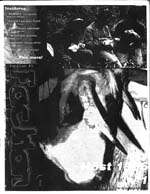

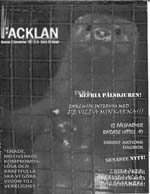

90s ALF press coverage: Alaskan Fur Co. and USDA arsons.
Random clips (1996 and 1998, various locations.)
Speciesism is so entrenched that your average person sees nothing wrong with the anal electrocution of a mink in order to steal their fur. This same person, however, will scream bloody murder over an empty building being set alight to prevent such torture. Our society habitually denounces those who resist our everyday cruelties, until somehow logic manages to penetrate and suddenly the rebels are seen as being right all along. At one point in the United States the majority of (invading European) citizens saw nothing wrong with human slavery, and newspapers shouted their outrage over slave revolts, the underground railroad, and the burning of auction blocks that sold thousands of people into bondage. Through the efforts of generations of abolitionists, however, the tide was eventually turned, and none of those aforementioned papers would now dream of supporting the slave trade. The rebels who were hated by the public, who were jailed and hanged and ridiculed to the delight of the media, are now seen as heroes.
There are, of course, very real differences between the movements to end human and non-human slavery, but the role of the media has remained very much the same. Luckily our movement has had, from time to time, articulate spokespeople who can explain why direct action is taken on behalf of animals. In the 1990s Freeman Wicklund, then the publisher of No Compromise magazine, would act as a press liaison in order to explain the motives of the underground. Later, Katie Fedor would start the North American Animal Liberation Front Press Office. Working closely with former ALF prisoners and the Canadian SG, she appeared regularly on television defending the actions of anonymous saboteurs. (As an interesting side note, Kevin Kjonaas once interned for Katie’s press office, and actually received college credits for defending the ALF!)
We present here several news clips featuring Freeman and Katie in the 90s doing one of the hardest jobs a good press officer must do: defending the use of arson to save animals.
DISCLAIMER: animal liberationist is an online archive preserving the history of protest movements for animal rights and environmentalism. Its owners, contributors, and designers are not responsible for actions taken by third parties which may be harmful or unlawful to the individuals or entities named in archived publications. This web site is provided for the purpose of historical research and analysis, and is not intended to incite, encourage, or condone any criminal action on the part of its readers. All opinions expressed in our archives are those of their original authors only.



